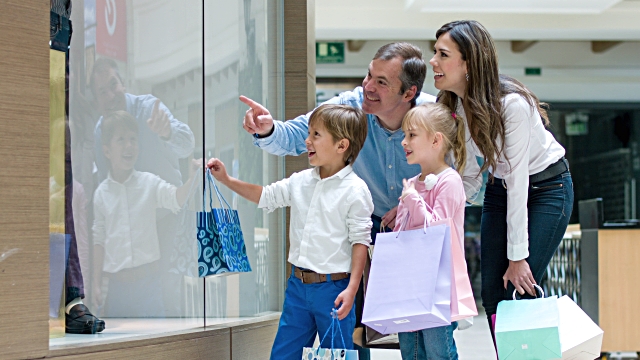6 WAYS TECHNOLOGY IS MAKING YOU A SMARTER SHOPPER
These tech tools help shoppers make grocery lists, comparison shop, and save money
The following story is presented by Fredrick Freedom and is designed to help you get the most value out of your grocery spending. Now through June 2017, receive 5% cashback on grocery and drug store expenses.
Today’s grocery shopper is equipped with smartphones and discerning tastes. And they’re pushing traditional grocers to transform their shopping experience, with a focus on technology.
Here are six ways that technology is impacting your trip to the supermarket:
1. AUTOMATED SHOPPING LISTS
Many major grocery chains now offer smartphone apps that let you easily create, edit, and share shopping lists, get weekly coupons and sales notifications, and more. Using one store’s app, Sajel Shah, a San Francisco, California publicist, simply “clips” coupons on her phone before visiting the store. “I have the app connected to my loyalty card account,” she says. So the app pulls up coupons, based on her previous purchases. “When I swipe the card at checkout,” she says, “all the coupons get applied to my order. Last night I saved 23 percent.”
2. SIMPLIFIED COMPARISON SHOPPING
A handful of apps make it easy to compare prices and weekly sales across multiple stores. Basket, a crowd-sourced app, works by having users report on prices as they shop, providing prices from 170,000 grocery and retail stores. Simply put your grocery list into Basket and they’ll tell you where that list of groceries will cost the least. Basket will also pull in any coupons that apply, for additional savings. “Users can save an average of 28 percent, before any coupons,” says Basket’s co-founder, Andy Ellwood.
Apps such as Favado and GroceryPal show weekly sales and special offers at stores on items you select, letting you compare deals. Both apps pull in available coupons that may lower the prices even more.
3. GETTING YOUR CASHBACK
No time to comparison-shop? You can still get cashback after leaving the store, simply by scanning your receipt into rebate apps such as Ibotta or Checkout 51. With both apps, you can browse available rebates before, or after, you shop, submit a picture of your receipt (or product bar code). The apps calculate rewards you’ve qualified for, and deposit the money into an account you create on the app.
“I actually don’t look through the app until after I shop,” says Malisa Lieser, a family meal-planning consultant in metropolitan Minneapolis. “That way, I’m not buying things just because they have a rebate, but rather saving on items that were already on my list.”

4. JOGGING YOUR MEMORY
Groceries have started using in-store Bluetooth transmitters and other tracking technologies to deliver personalized messages, based on information about a user’s location transmitted by their mobile phones. If you use a shopping or recipe app (with location services enabled), you may see messages popping up on your phone—from the store or brand sponsors—alerting you to sales, delivering coupons, suggesting a recipe, or giving you a heads-up about the special display that’s right in front of you.
David Eyler, a financial planner in Vermont, keeps his shopping list in an app, which he’s set with his local grocery store’s address. “I’m automatically reminded to stop at the grocery store and pick up items on my lists when I drive near its location,” he says.
5. STREAMLINED CHECKOUT
Amazon is exploring hybrid grocery store models that combine the seamless convenience of online shopping with a brick-and-mortar store.
In 2016, for example, the company launched Amazon Go, its first brick-and-mortar grocery store, in Bellevue, Washington. As customers enter the store, they are logged in with their phones. Sensors track what items they take from the shelf. And as they walk out the door, their bill is automatically tallied and charged to their account.
Other retailers are experimenting with ways to speed checkout, with apps that let shoppers scan items, and compare prices, as they add them to the their cart, pay online, and show a QR code receipt at the door. In 2010, the Kroger supermarket chain started using QueVision, a system of sensors and predictive analytics to anticipate when customers are about to crush the checkout lines, sending in additional cashiers and helping to cut average wait time from four minutes to less than 30 seconds.

6. KEEPING YOU ROLLING
Drive-through is also on the rise. Amazon Fresh has drive-through locations in metropolitan Seattle, where customers pull up beneath an awning to collect groceries they’ve ordered online.
Other retailers–even wholesale shopping clubs–are offering shoppers the chance to gain back time (and money) by picking up groceries at drive-through services. Liza Newman Shaw, a family therapist and mother of two teens in North Carolina, says she “mostly loves” the curbside pick-up option her regional grocery chain offers. “I order the food online and drive up, swipe the card, and they bring it out to my car.,” she says, adding, “I don’t use it every week, but it is extremely convenient for when I have been too busy to stroll the aisles myself.”
Another popular option is delivery service. “Time not spent at the grocery store or in traffic is time I can work or do something I actually enjoy,” says Lisa Hazen, a graphic designer and mother of two in Bellevue, Washington.
Lisa regularly orders from a delivery service, which uses a network of freelance shoppers to pick up and deliver items from stores to customers, once or twice a week. Ordering online isn’t just more convenient, says Hazen, but also helps her family stick to a budget. “Impulse buys are pretty much eliminated,” she says, adding, “I’m able to check items off my list from recipes and stick to a meal plan for the week.”



